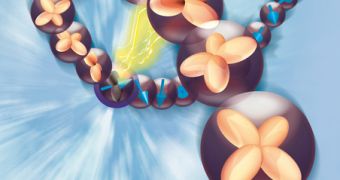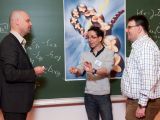Electrons, for a long time thought to be elementary particles, can be split into two separate parts, an international team of experts demonstrated in a new study. Each of the two resulting particles carries one of the two most important properties of electrons.
When broken apart, an electron produces a spinon – a particle that goes on carrying its former spin – and an orbiton – a particle that carries the previous orbital moment. Neither of the two resulting particles can exit the material in which they were produced, the team says.
Details of the new study were published in the April 18 online issue of the top scientific journal Nature. The research group was spearheaded by experts at the Paul Scherrer Institute, in Switzerland, and theoretical physicists from the IFW Dresden, in Germany.
In order to split the two main properties of each individual electron – spin and orbital – investigators fired X-rays from the Swiss Light Source (SLS) into samples of the copper-oxide compound Sr2CuO3.
Physicists explain that electronic spin is the property that gives rise to magnetism. In addition, each electron prefers to orbit around the atomic nucleus on a certain path, or orbital, similar to how different satellites around Earth take distinct orbit according to the function they fulfill.
Usually, both quantum properties are attached to the same electron. What the research group did was use X-rays to separate these two intrinsic traits. The compound Sr2CuO3 was used for this application because particles contained within can move in only one direction at a time.
By firing the SLS X-rays into the test sample, scientists basically forced some electrons orbiting copper atom nuclei inside the compound to move to orbitals of higher energy. This means that the particles started moving faster around the nuclei.
After this is done, the electron splits into a spinon and orbiton. The new investigation is the first ever to observe this process as it happened. Certain theories suggested that electrons can be split under certain conditions a long time ago.
“These experiments not only require very intense X-rays, with an extremely well-defined energy, to have an effect on the electrons of the copper atoms, but also extremely high-precision X-ray detectors. In this respect, the SLS at the Paul Scherrer Institute is leading the world at the moment,” team leader Thorsten Schmit explains.
“It had been known for some time that, in particular materials, an electron can in principle be split, but until now the empirical evidence for this separation into independent spinons and orbitons was lacking,” investigator Jeroen van den Brink adds.
“Now that we know where exactly to look for them, we are bound to find these new particles in many more materials,” says the scientist, who leads the theory team at the IFW Dresden.

 14 DAY TRIAL //
14 DAY TRIAL // 
